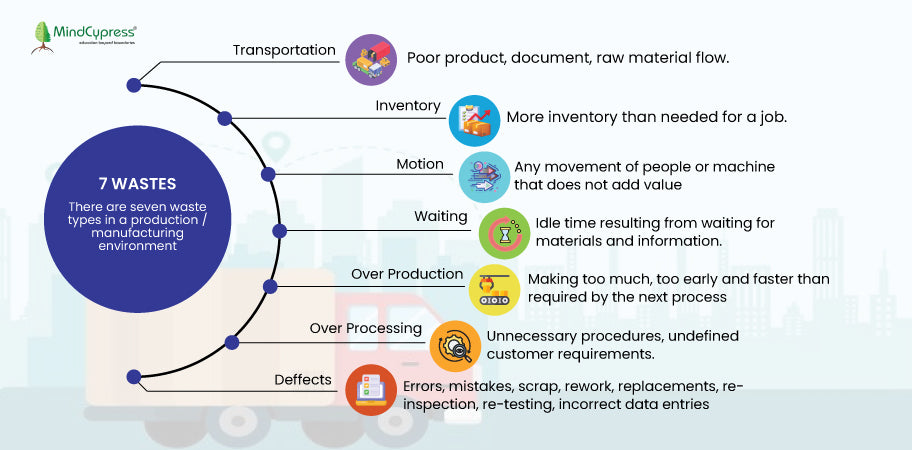TIMWOOD Analysis: Identifying and Eliminating Waste in Business Processes
The business landscape is heavily competitive today. Organizations have started focusing on ways that can help improve efficiency, save expenditures and increase customer satisfaction. To achieve this goal, businesses use TIMWOOD analysis, a crucial part under Lean Six Sigma. TIMWOOD analysis is helpful for organizations in identifying and eliminating lean six sigma waste in business processes.
In this blog, we will understand the fundamentals, principles and importance of TIMWOOD analysis along with effective strategies for it.

Understanding TIMWOOD Analysis
There are seven types of waste in Lean Six Sigma and TIMWOOD is an acronym derived from the same. It refers to the waste that business processed commonly consist:
Transportation: Movement of materials for no reason or information between workstations or locations.
Inventory: Excess inventory that ties up capital and leads to storage costs, obsolescence, and waste.
Motion: Non-essential movement of people, equipment, or machinery.
Waiting: Time spent waiting for materials, information, equipment, or approvals for next steps.
Overproduction: Producing more than necessary or before it is needed.
Over processing: Performing unnecessary or redundant steps in a process.
Defects: Errors, defects, or rework that result in scrap, rejections, customer complaints, and additional costs.
The goal of TIMWOOD analysis is to identify and eliminate these forms of waste. Thereby, improving process efficiency, reducing costs, and enhancing overall performance. You can enroll for a lean six sigma green belt certification course to learn more about TIMWOOD Analysis.
Importance of TIMWOOD Analysis in Lean Six Sigma
TIMWOOD analysis is a foundational concept in Lean Six Sigma methodology, which aims to minimize waste and maximize value for the customer. By conducting TIMWOOD analysis, organizations can:
Identify Opportunities for Improvement: TIMWOOD analysis helps organizations identify inefficiencies, bottlenecks, and areas of waste in their processes, providing insights into opportunities for improvement.
Streamline Operations: By eliminating waste, organizations can streamline their operations, reduce cycle times, and improve throughput, leading to increased productivity and efficiency.
Enhance Customer Satisfaction: By delivering products or services more quickly, reliably, and cost-effectively, organizations can enhance customer satisfaction and loyalty.
Reduce Costs: Eliminating waste reduces costs associated with excess inventory, unnecessary processing, defects, and rework, leading to improved profitability.
Drive Continuous Improvement: TIMWOOD analysis is not a one-time exercise but rather an ongoing process of continuous improvement. By continually monitoring and optimizing their processes, organizations can maintain a competitive edge and adapt to changing market conditions.
Practical Strategies for Identifying and Eliminating Waste
Value Stream Mapping: Conducting value stream mapping exercises to visualize and analyze end-to-end processes, identify waste, and design future state maps that optimize flow and efficiency.
Kaizen Events: Organizing Kaizen events or rapid improvement workshops to engage cross-functional teams in identifying and implementing solutions to eliminate waste and improve processes.
Standard Work: Establishing standard work procedures and work instructions to ensure consistency, reduce variability, and eliminate waste in processes.
Error-Proofing (Poka-Yoke): Implementing error-proofing techniques to prevent defects and errors from occurring in processes, thereby reducing waste and rework.
Continuous Monitoring and Improvement: Continuously monitoring process performance metrics, soliciting feedback from stakeholders, and implementing incremental improvements to eliminate waste and optimize processes over time.
Conclusion:
TIMWOOD analysis is a powerful tool for identifying and eliminating waste in business processes. It drives efficiency, reduces costs, and enhances customer satisfaction. Organizations can streamline their operations by understanding the seven types of waste and applying practical strategies for waste elimination. They can also improve productivity, and achieve sustainable competitive advantage in today's competitive business environment. By incorporating TIMWOOD analysis into their Lean Six Sigma initiatives, organizations can unlock new opportunities for process improvement and drive continuous innovation and excellence.
To get a better understanding of TIMWOOD Analysis or Lean Six Sigma waste, it is best to learn from professionals. Enroll in Lean Six Sigma Green Belt Certification course by MindCypress. It is a learning platform that helps individuals gain new skills or hone existing one. The certifications can increase your value in the market, wherever you go.
